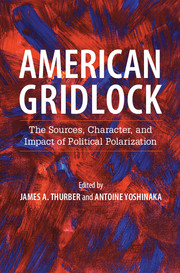Book contents
- Frontmatter
- Dedication
- Contents
- List of contributors
- Foreword
- Acknowledgments
- Introduction
- PART I POLARIZATION AMONG VOTERS AND ACTIVISTS
- PART II POLARIZATION IN NATIONAL INSTITUTIONS
- PART III POLARIZATION IN THE STATES
- PART IV POLARIZATION IN THE MEDIA
- PART V IMPLICATIONS AND CONCLUSIONS
- 16 Congressional Polarization and Its Connection to Income Inequality: An Update
- 17 The Sources and Impact of Political Polarization
- Index
- References
16 - Congressional Polarization and Its Connection to Income Inequality: An Update
from PART V - IMPLICATIONS AND CONCLUSIONS
Published online by Cambridge University Press: 05 November 2015
- Frontmatter
- Dedication
- Contents
- List of contributors
- Foreword
- Acknowledgments
- Introduction
- PART I POLARIZATION AMONG VOTERS AND ACTIVISTS
- PART II POLARIZATION IN NATIONAL INSTITUTIONS
- PART III POLARIZATION IN THE STATES
- PART IV POLARIZATION IN THE MEDIA
- PART V IMPLICATIONS AND CONCLUSIONS
- 16 Congressional Polarization and Its Connection to Income Inequality: An Update
- 17 The Sources and Impact of Political Polarization
- Index
- References
Summary
• Polarization in Congress is the highest since Reconstruction.
• Polarization is not an artifact of roll call voting. It also occurs in campaign contributions.
• Polarization in Congress is largely due to the Republican Party becoming more conservative.
• Polarization and income inequality appear to be mutually causal.
INTRODUCTION
This essay updates our findings on political polarization in Congress and elite political actors who work through Congress to affect public policy. We also link various threads of our research with the other essays in this volume. We begin with a discussion of the methodologies that enabled us to identify the emergence of political polarization in Congress, and then turn to substantive results.
A BRIEF HISTORY OF D-NOMINATE AND DW-NOMINATE
In 1984, we (Poole and Rosenthal) published a paper in the Journal of Politics titled “The Polarization of American Politics.” We found that beginning in the mid-1970s, American politics became much more divisive at the congressional level. More Democratic legislators staked out consistently liberal positions, and more Republicans supported wholly conservative ones. The primary evidence in that study, which focused exclusively on the Senate, were ratings issued by interest groups such as the Americans for Democratic Action and the United States Chamber of Commerce.
These early findings motivated us to develop better measures of legislative ideology. Because interest group ratings are in fact aggregations of legislator roll call voting decisions, we believed that much better information would be available by scaling the individual roll call votes directly. Consequently, we adapted the standard dichotomous logit (or probit) model to develop the NOMINATE (Nominal Three-step Estimation) procedure.
NOMINATE is based on a simple spatial model of voting behavior. Each legislator is represented by a single point, and each roll call is represented by two points – one for the “yea” position and one for “nay.” These points form a spatial map that summarizes the roll calls. This spatial map is much like a road map. Tables in road atlases that tabulate the distances between every pair of sizable cities in the United States contain much the same information as the corresponding map of the United States, but a table gives you no idea what the U.S. looks like. Indeed, atlases contain maps as well as a table. Much like a road map, a spatial map formed from roll calls gives us a way of visualizing the political world of a legislature.
- Type
- Chapter
- Information
- American GridlockThe Sources, Character, and Impact of Political Polarization, pp. 357 - 377Publisher: Cambridge University PressPrint publication year: 2015
References
- 3
- Cited by

